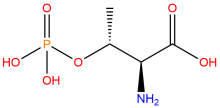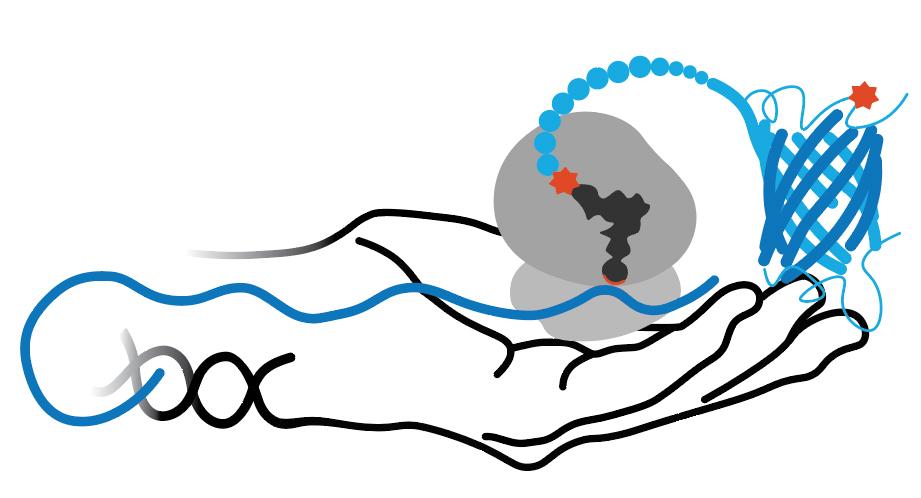RS/tRNA Foundational Publication Support
Zhang, Michael Shaofei, Simon F Brunner, Nicolas Huguenin-Dezot, Alexandria D Liang, Wolfgang H Schmied, Daniel T Rogerson, and Jason W Chin. (2017) 2017. “Biosynthesis And Genetic Encoding Of Phosphothreonine Through Parallel Selection And Deep Sequencing.”. Nature Methods 14 (7): 729-736. doi:10.1038/nmeth.4302.
Moen, Jack M, Kyle Mohler, Svetlana Rogulina, Xiaojian Shi, Hongying Shen, and Jesse Rinehart. (2022) 2022. “Enhanced Access To The Human Phosphoproteome With Genetically Encoded Phosphothreonine.”. Nature Communications 13 (1): 7226. doi:10.1038/s41467-022-34980-5.
RS/tRNA Pair Development Year
2017
ncAA(s) Incorporated
phosphothreonine
ncAA Structure (png, jpg, jpeg)

ncAA Utility
Used to produce site-specifically phosphorylated proteins at a threonine residue via genetic code expansion.
RS Organism of Origin
Parent RS
RS Mutations
G320A
L321Y
E412P
E414F
P495M
I496W
F529S
L321Y
E412P
E414F
P495M
I496W
F529S
tRNA Organism of Origin
Parent tRNA
tRNA Anticodon
CUA
Other tRNA Mutations
C2U
G4C
G6C
G29A
A31U
G34C
C35U
G37A
U39A
C40U
C41U
C67G
C69G
G71A
G4C
G6C
G29A
A31U
G34C
C35U
G37A
U39A
C40U
C41U
C67G
C69G
G71A
Multiple tRNAs?
2022 paper also found that adding C3G, C70U and U73A mutations to tRNA-pSer made it a substrate for AlaRS (i.e. a suppressor tRNA-Ala) allowing the GCE system with that tRNA to place a non-phosphorylatable Ala residue in place of pThr.
RS/tRNA Availability
Addgene #173899 is for the plasmid for pThrRS, EFSep, Sep-tRNA-v2 and PduX (which is a Thr kinase).
Addgene #174075 and #174076 are for control sfGFP WT and 150TAG, respectively (not originally used with this system, but work well with it). For any POI, clone it in place of sfGFP in these plasmids.
Competent cells of BL21(DE3) ΔserC ΔycdX can be purchased commercially from Amid Biosciences (Catalog # BLPCY-201).
Addgene #174075 and #174076 are for control sfGFP WT and 150TAG, respectively (not originally used with this system, but work well with it). For any POI, clone it in place of sfGFP in these plasmids.
Competent cells of BL21(DE3) ΔserC ΔycdX can be purchased commercially from Amid Biosciences (Catalog # BLPCY-201).
Used in what cell line?
RS/tRNA Additional Notes
The two additional mutations to SepRS2 yield pThrRS with specificity for pThr. These are G320A and L321Y.
The PduX gene is a free threonine kinase that synthesizes pThr intracellularly. The 2017 system also used EF-Sep (in place of EF-Tu) and gave full-fidelity pThr protein production in E coli, with sfGFP(150) yielding 5 mg/L, and also producing dual pThr sfGFP(150/156), ubiquitin(12), ubiquitin(66), and a cyclin-dep kinase 2(160) with a D145N inactivating mutation. Knocking out the ycdX phosphatase gene was essential to limit dephosphorylation of the pThr protein produced.
The 2022 E coli system was developed to use the Hi-P approach to study pThr-dependent protein-protein interactions of peptides that constitute the human pThr proteome using the quadruple knockout C321.ΔA strain (the triple knockout BL21(DE3) strain produced pThr protein, but was not useful for the Hi-P analysis). Neither strain gave full-fidelity incorporation of pThr, but that was not necessary for probing protein-protein interactions. pphA is an additional phosphatase removed, and removing the relA "stringent response" protein was removed improved protein production in the C321.ΔA strain allowing Hi-P studies. This GCE system also used EF-Sep21 in place of EF-Sep.
The PduX gene is a free threonine kinase that synthesizes pThr intracellularly. The 2017 system also used EF-Sep (in place of EF-Tu) and gave full-fidelity pThr protein production in E coli, with sfGFP(150) yielding 5 mg/L, and also producing dual pThr sfGFP(150/156), ubiquitin(12), ubiquitin(66), and a cyclin-dep kinase 2(160) with a D145N inactivating mutation. Knocking out the ycdX phosphatase gene was essential to limit dephosphorylation of the pThr protein produced.
The 2022 E coli system was developed to use the Hi-P approach to study pThr-dependent protein-protein interactions of peptides that constitute the human pThr proteome using the quadruple knockout C321.ΔA strain (the triple knockout BL21(DE3) strain produced pThr protein, but was not useful for the Hi-P analysis). Neither strain gave full-fidelity incorporation of pThr, but that was not necessary for probing protein-protein interactions. pphA is an additional phosphatase removed, and removing the relA "stringent response" protein was removed improved protein production in the C321.ΔA strain allowing Hi-P studies. This GCE system also used EF-Sep21 in place of EF-Sep.
